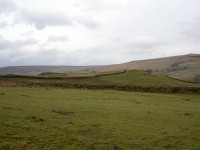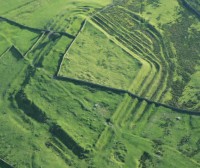 Whitley Castle, a.k.a. Epiacum, is a Roman fort in Northumberland close to the border with Cumbria, 12 miles south of Hadrian’s Wall. It’s also a scheduled ancient monument, a legal designation that prohibits all excavation on the site. Not even the landowners (Elaine and John Edgar of Castle Nook farm) are allowed to touch the soil. Moles, however, care not for our puny human “laws.” Moles laugh in the court’s collective peruked face and dig with impunity as deep under the fort as their little hearts desire.
Whitley Castle, a.k.a. Epiacum, is a Roman fort in Northumberland close to the border with Cumbria, 12 miles south of Hadrian’s Wall. It’s also a scheduled ancient monument, a legal designation that prohibits all excavation on the site. Not even the landowners (Elaine and John Edgar of Castle Nook farm) are allowed to touch the soil. Moles, however, care not for our puny human “laws.” Moles laugh in the court’s collective peruked face and dig with impunity as deep under the fort as their little hearts desire.
Seizing the opportunity afforded by the moles’ tireless efforts, a team of 37 volunteers assembled on the site to sift carefully through the molehills for ancient artifacts under the careful supervision of English Heritage whose presence made the sifting legal and who assessed the artifacts as they were found.
Among the finds were:
A quarter-inch-long piece of rare Samian ware, tableware known as the classic Roman ceramic discovery;
A number of pottery rim fragments from Roman serving bowls and earthenware pots;
A jet bead from a Roman necklace or bracelet.
Roman pieces that had been brought to the surface by the dirt-churning vigor of the moles were found last year too, including a number of nails that confirmed the fort was not solely built out of stone but also of wood. A visitor on a guided walk stumbled on a small bronze dolphin that might have been part of a bath tap.
For now, the Roman artifacts are in the care of Paul Frodshaw, one of the directors of Epiacum Heritage Ltd, a company dedicated to the promotion and development of Epiacum. Elaine Edgar is a co-founder and one of the directors. Frodshaw will catalogue every artifact before returning them to the landowners. Edgar just this month received a £49,200 Heritage Lottery grant which Epiacum Heritage plans to use to raise the profile of the fort as a tourist attraction. The ultimate aim is to have all the artifacts the moles have unearthed be part of an on-site display.
 Epiacum is the highest stone Roman fort in Britain. Its unique diamond-shaped structure once housed a garrison of about 500 Roman soldiers who were probably in charge of supervising local lead and silver mining operations. It was built at the same time as Hadrian’s Wall (ca. 122 A.D.), but the wall a dozen miles away gets thousands of visitors each year, while Epiacum, despite its unusual design, extensive remains including a civilian settlement, a bath house, some of the best preserved stone ramparts in the entire Roman Empire, not to mention the in-house mole archaeologists, goes almost entirely unnoticed.
Epiacum is the highest stone Roman fort in Britain. Its unique diamond-shaped structure once housed a garrison of about 500 Roman soldiers who were probably in charge of supervising local lead and silver mining operations. It was built at the same time as Hadrian’s Wall (ca. 122 A.D.), but the wall a dozen miles away gets thousands of visitors each year, while Epiacum, despite its unusual design, extensive remains including a civilian settlement, a bath house, some of the best preserved stone ramparts in the entire Roman Empire, not to mention the in-house mole archaeologists, goes almost entirely unnoticed.
It never really has gotten the attention it is due. Small excavations in the 19th and first half of the 20th centuries turned up a number of important artifacts like intact leather shoes, coins, pottery and altars to Apollo, Hercules, Minerva and Mithras. Nonetheless, even before it became a scheduled monument Epiacum was barely touched.
The new corporation has plans to create an interpretation center and hopefully lure tourists to the “hidden gem of the North pennines” but they’ll need to raise more funds to make it happen. They also need volunteers to help develop the site within the parameters of the scheduled ancient monument designation. For instance, volunteers can help survey the site in more detail, adding to our understanding of the fort and its occupants during its 200 or so years of habitation. If you’re interesting in volunteering, click on the Help Out page of the website and fill in the email form. Follow Epiacum Heritage’s progress on Twitter @epiacum.
Many thanks to Elaine Edgar for correcting some errors in this entry and for sharing information about Epiacum Heritage’s goals. :thanks:
A few slight inaccuraices – but thanks for the profile of this story.
Epiacum Heritage Ltd ran this event – Eng Heritage only watched (to make it legal) and assessed finds.
The dolphin was found last year by someone on site during a guided walk,which inspired Paul Frodsham to set up this activity.
we will use the current £50000 grant to rasie the profile of the site and seek further funding to develop full visitor facilities. It is a great site to see but there is still lots to do in terms of interpretation to increase understanding. Events programme to be developed over the life of the 18 month project. Follow pogress on twitter @epiacum – the “hidden gem of the North pennines”
Thank you so much for the corrections and additional information. I’ve updated the entry accordingly. Should I ever be fortunate to find myself up Castle Nook way, I’ll most assuredly visit the hidden gem of the North pennines. :hattip:
good to hear the progressive news concerning the site, I have used epiacum in my e mail for years , my main interest and development is roman artillery, I am a member of the Ermine street guard, if you require any help let me know,artillery available for a good cause.
Thank you kindly for commenting, Tom. Due to an annoying software glitch, comments on this blog won’t nest unless they’re posted through the admin control panel, so I’m going to paste Elaine Edgar’s reply to you just to be sure you don’t miss it.
Instead of artillery, I suggest that the Heritage Lottery Fund should deploy some marmots. As Herodotus has put it 2500 years ago:
“In this desert, there live amid the sand great marmots, in size somewhat less than dogs, but bigger than foxes. The Persian king has a number of them, which have been caught by the hunters in the land whereof we are speaking. Those marmots make their dwellings under ground, and like the Greek ones, which they very much resemble in shape, throw up sand-heaps as they burrow. Now the sand which they throw up is full of gold.” 😀
:hattip:
please contact me via our website (www.epiacumheritage.org) – it is only under construction but there is a “help out” tab where comments reach me direct through my eamil. We are certainly looking for all kinds of interpretation, including re-enactment.Lots to plan and develop within the current constraints of facilities on site – but without trying to get people here we will never manage to attract future funding for the real deal in terms of visitor centre etc. We’re trying!!
Cheers for that! Looking forward to developing the dream!- and to seeing the benefits to the local area grow too. Yes, come and visit – but hopefully in the future we’ll be able to offer you a nice cuppa after a walk around the site!! :yes: